Cisco Systems Unified MeetingPlace Web Conferencing User Manual
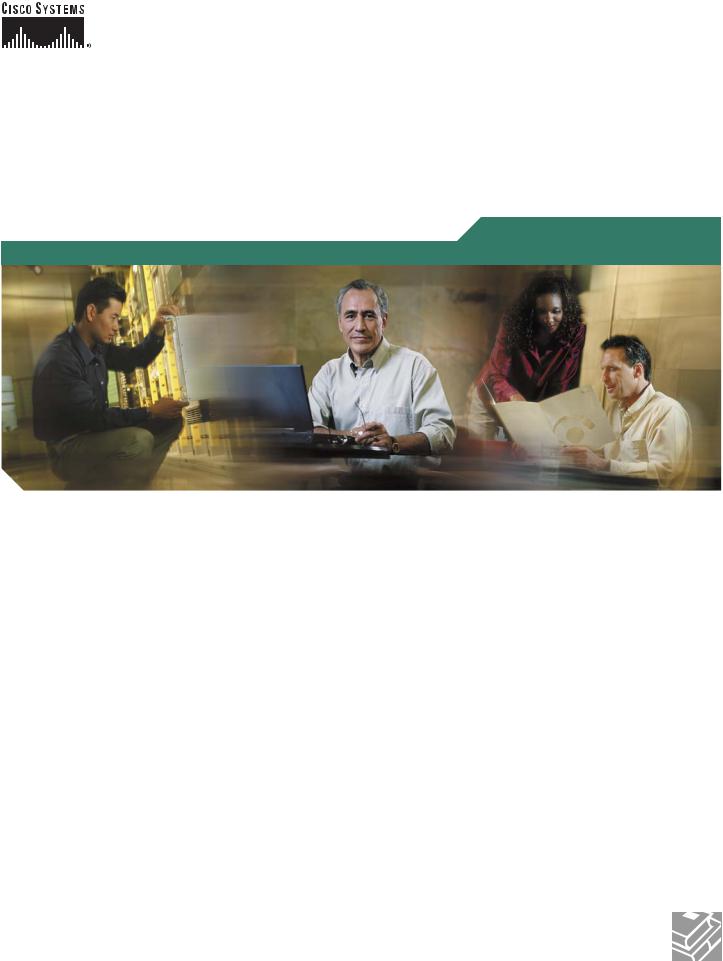
Installation and Upgrade Guide for Cisco Unified MeetingPlace Web Conferencing
Release 6.x
May 31, 2007
Corporate Headquarters
Cisco Systems, Inc. 170 West Tasman Drive
San Jose, CA 95134-1706 USA http://www.cisco.com Tel: 408 526-4000
800 553-NETS (6387) Fax: 408 526-4100
Text Part Number: OL-13418-01
THE SPECIFICATIONS AND INFORMATION REGARDING THE PRODUCTS IN THIS MANUAL ARE SUBJECT TO CHANGE WITHOUT NOTICE. ALL STATEMENTS, INFORMATION, AND RECOMMENDATIONS IN THIS MANUAL ARE BELIEVED TO BE ACCURATE BUT ARE PRESENTED WITHOUT WARRANTY OF ANY KIND, EXPRESS OR IMPLIED. USERS MUST TAKE FULL RESPONSIBILITY FOR THEIR APPLICATION OF ANY PRODUCTS.
THE SOFTWARE LICENSE AND LIMITED WARRANTY FOR THE ACCOMPANYING PRODUCT ARE SET FORTH IN THE INFORMATION PACKET THAT SHIPPED WITH THE PRODUCT AND ARE INCORPORATED HEREIN BY THIS REFERENCE. IF YOU ARE UNABLE TO LOCATE THE SOFTWARE LICENSE OR LIMITED WARRANTY, CONTACT YOUR CISCO REPRESENTATIVE FOR A COPY.
The Cisco implementation of TCP header compression is an adaptation of a program developed by the University of California, Berkeley (UCB) as part of UCB’s public domain version of the UNIX operating system. All rights reserved. Copyright © 1981, Regents of the University of California.
NOTWITHSTANDING ANY OTHER WARRANTY HEREIN, ALL DOCUMENT FILES AND SOFTWARE OF THESE SUPPLIERS ARE PROVIDED “AS IS” WITH ALL FAULTS. CISCO AND THE ABOVE-NAMED SUPPLIERS DISCLAIM ALL WARRANTIES, EXPRESSED OR IMPLIED, INCLUDING, WITHOUT LIMITATION, THOSE OF MERCHANTABILITY, FITNESS FOR A PARTICULAR PURPOSE AND NONINFRINGEMENT OR ARISING FROM A COURSE OF DEALING, USAGE, OR TRADE PRACTICE.
IN NO EVENT SHALL CISCO OR ITS SUPPLIERS BE LIABLE FOR ANY INDIRECT, SPECIAL, CONSEQUENTIAL, OR INCIDENTAL DAMAGES, INCLUDING, WITHOUT LIMITATION, LOST PROFITS OR LOSS OR DAMAGE TO DATA ARISING OUT OF THE USE OR INABILITY TO USE THIS MANUAL, EVEN IF CISCO OR ITS SUPPLIERS HAVE BEEN ADVISED OF THE POSSIBILITY OF SUCH DAMAGES.
CCVP, the Cisco logo, and the Cisco Square Bridge logo are trademarks of Cisco Systems, Inc.; Changing the Way We Work, Live, Play, and Learn is a service mark of Cisco Systems, Inc.; and Access Registrar, Aironet, BPX, Catalyst, CCDA, CCDP, CCIE, CCIP, CCNA, CCNP, CCSP, Cisco, the Cisco Certified Internetwork Expert logo, Cisco IOS, Cisco Press, Cisco Systems, Cisco Systems Capital, the Cisco Systems logo, Cisco Unity, Enterprise/Solver, EtherChannel, EtherFast, EtherSwitch, Fast Step, Follow Me Browsing, FormShare, GigaDrive, HomeLink, Internet Quotient, IOS, iPhone, IP/TV, iQ Expertise, the iQ logo, iQ Net Readiness Scorecard, iQuick Study, LightStream, Linksys, MeetingPlace, MGX, Networking Academy, Network Registrar, Packet, PIX, ProConnect, ScriptShare, SMARTnet, StackWise, The Fastest Way to Increase Your Internet Quotient, and TransPath are registered trademarks of Cisco Systems, Inc. and/or its affiliates in the United States and certain other countries.
All other trademarks mentioned in this document or Website are the property of their respective owners. The use of the word partner does not imply a partnership relationship between Cisco and any other company. (0705R)
Any Internet Protocol (IP) addresses used in this document are not intended to be actual addresses. Any examples, command display output, and figures included in the document are shown for illustrative purposes only. Any use of actual IP addresses in illustrative content is unintentional and coincidental.
Installation and Upgrade Guide for Cisco Unified MeetingPlace Web Conferencing Release 6.x
© 2007 Cisco Systems, Inc. All rights reserved.
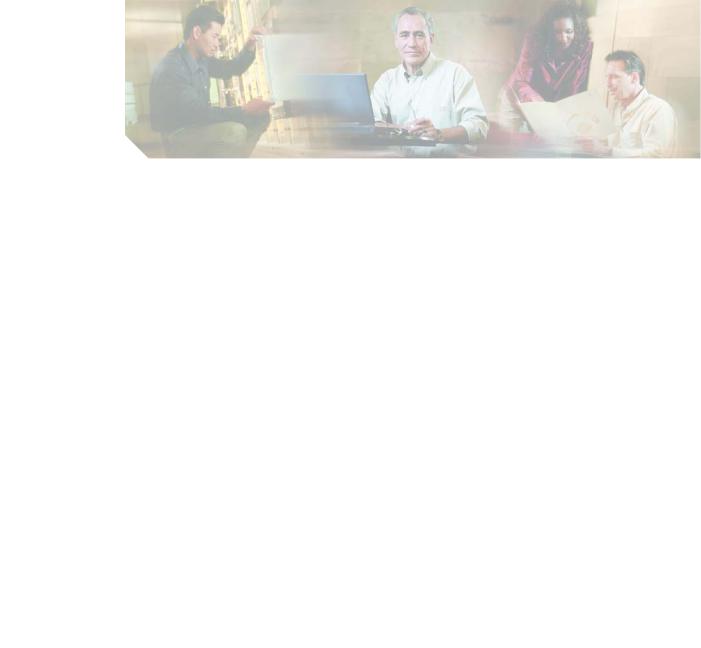
C O N T E N T S
|
|
Preface vii |
|
|
|
|
|
|
|
|
|
|
|
|
|
|
Purpose |
ii-vii |
|
|
|
|
|
|
|
|
|
|
|
|
|
Audience |
ii-vii |
|
|
|
|
|
|
|
|
|
|
|
|
|
Naming Conventions ii-viii |
|
|
|
|
|
|
|
|
|
|||
|
|
Documentation Conventions |
|
ii-ix |
|
|
|
|
|
|
|
|
||
|
|
Cisco Unified MeetingPlace Documentation |
ii-x |
|
|
|
|
|
|
|||||
|
|
Obtaining Documentation |
ii-x |
|
|
|
|
|
|
|
|
|||
|
|
Cisco.com |
ii-x |
|
|
|
|
|
|
|
|
|
|
|
|
|
Product Documentation DVD |
ii-x |
|
|
|
|
|
|
|
||||
|
|
Ordering Documentation |
ii-x |
|
|
|
|
|
|
|
|
|||
|
|
Documentation Feedback |
ii-xi |
|
|
|
|
|
|
|
|
|||
|
|
Cisco Product Security Overview |
ii-xi |
|
|
|
|
|
|
|
||||
|
|
Reporting Security Problems in Cisco Products |
ii-xi |
|
|
|
|
|||||||
|
|
Product Alerts and Field Notices |
ii-xii |
|
|
|
|
|
|
|
||||
|
|
Obtaining Technical Assistance ii-xii |
|
|
|
|
|
|
|
|||||
|
|
Cisco Support Website |
|
ii-xii |
|
|
|
|
|
|
|
|
||
|
|
Submitting a Service Request |
ii-xiii |
|
|
|
|
|
|
|
||||
|
|
Definitions of Service Request Severity |
ii-xiii |
|
|
|
|
|
||||||
|
|
Obtaining Additional Publications and Information |
ii-xiv |
|
|
|
|
|||||||
|
Introducing Cisco Unified MeetingPlace Web Conferencing |
|
|
|
|
|||||||||
C H A P T E R 1 |
1-1 |
|
|
|
||||||||||
|
|
About Cisco Unified MeetingPlace |
1-1 |
|
|
|
|
|
|
|
||||
|
|
About Cisco Unified MeetingPlace Web Conferencing |
1-1 |
|
|
|
|
|||||||
|
|
Overview of Web Conferencing Components |
1-2 |
|
|
|
|
|
||||||
|
|
Benefits of Web Conferencing |
1-3 |
|
|
|
|
|
|
|
||||
|
|
Overview of the Cisco MeetingPlace Agent Service |
1-4 |
|
|
|
|
|||||||
|
|
Terms of Use |
1-7 |
|
|
|
|
|
|
|
|
|
|
|
|
|
Configuration Restrictions |
1-7 |
|
|
|
|
|
|
|
||||
|
|
Cisco Policy for Use of Third-Party Software |
1-7 |
|
|
|
|
|
||||||
|
|
Terms for Single Sign On Software Integration |
1-7 |
|
|
|
|
|||||||
|
|
Terms of Support for Single Sign On Software Integration |
1-8 |
|
|
|
||||||||
|
|
New Feature and Enhancement Information |
1-9 |
|
|
|
|
|
|
|||||
|
|
|
Installation and Upgrade Guide for Cisco Unified MeetingPlace Web Conferencing Release 6.x |
|
|
|
||||||||
|
|
|
|
|||||||||||
|
|
|
|
|
|
|
|
|
|
|
|
|
|
|
|
OL-13418-01 |
|
|
|
|
|
|
|
|
|
|
|
iii |
|
|
|
|
|
|
|
|
|
|
|
|
|
|
||
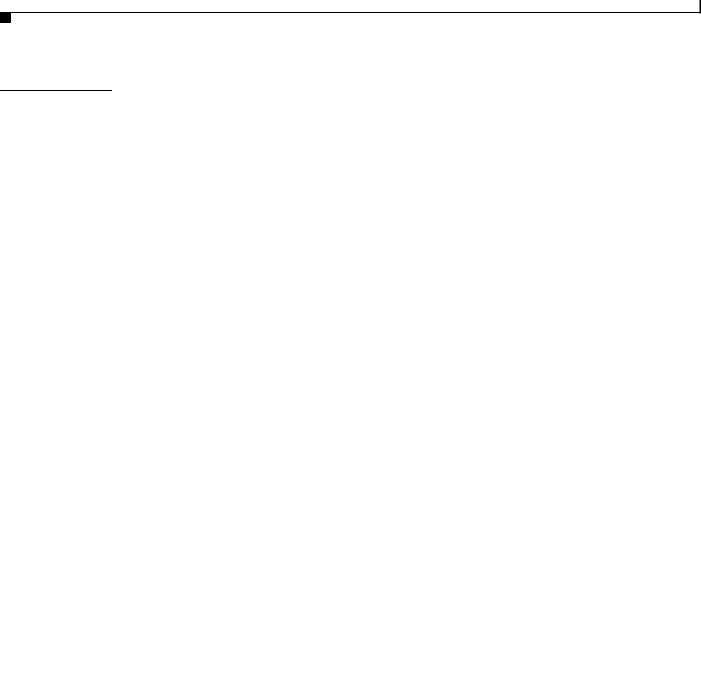
Contents
C H A P T E R 2 |
Installing Web Conferencing 2-1 |
|
|
Preinstallation Tasks: Web Conferencing 2-1 |
|
|
Installing Cisco Unified MeetingPlace Audio Server 2-2 |
|
|
Planning Web Conferencing License Usage |
2-2 |
|
Installing SQL Server on a Remote Server |
2-2 |
|
|
|
|
|
Gathering Web Conferencing Installation Values 2-3 |
|
|
|
|
|
|
|
||
|
|
|
|
|
Installation Tasks: Web Conferencing |
2-5 |
|
|
|
|
|
|
|
|
|
|
|
|
|
Installing the Operating System on the Cisco MCS Server |
|
2-5 |
|
|
|
|
|
||
|
|
|
|
|
Configuring Network Settings on the Cisco MCS Server |
2-5 |
|
|
|
|
|
|||
|
|
|
|
|
Installing Web Conferencing |
2-9 |
|
|
|
|
|
|
|
|
|
|
|
|
|
Postinstallation Tasks: Web Conferencing 2-12 |
|
|
|
|
|
|
|
||
|
|
|
|
|
Defining the Web Conferencing Server Hostname Information |
2-12 |
|
|
|
|||||
|
|
|
|
|
Testing the Web Conferencing Installation 2-13 |
|
|
|
|
|
|
|
||
|
|
|
|
|
Installing the Cisco Security Agent for Cisco Unified MeetingPlace Web Conferencing 2-14 |
|||||||||
|
|
|
|
|
Creating and Using a Least-Privileged SQL Account for Web Conferencing |
2-14 |
|
|||||||
|
|
|
|
|
Configuring SSL 2-16 |
|
|
|
|
|
|
|
|
|
|
|
|
Installing Web Conferencing for a Segmented Meeting Access Configuration |
|
|
|||||||||
C H A P T E R |
3 |
|
3-1 |
|
||||||||||
|
|
|
|
|
About Segmented Meeting Access |
3-1 |
|
|
|
|
|
|
|
|
|
|
|
|
|
About the SMA-2S Configuration |
3-2 |
|
|
|
|
|
|
|
|
|
|
|
|
|
About the SMA-2S Configuration with SSL and Segmented DNS |
3-3 |
|
|
|
|||||
|
|
|
|
|
About the SMA-2S Configuration and Video-Enabled Systems |
3-4 |
|
|
|
|
||||
|
|
|
|
|
Preinstallation Tasks: Web Conferencing in an SMA-2S Configuration |
3-4 |
|
|
|
|||||
|
|
|
|
|
Installation Tasks: Web Conferencing in an SMA-2S Configuration |
3-5 |
|
|
|
|
||||
|
|
|
|
|
Copying GUIDS from the Internal Web Server to the External Web Server |
3-5 |
|
|
||||||
|
|
|
|
|
Postinstallation Tasks: Web Conferencing in an SMA-2S Configuration |
3-6 |
|
|
|
|||||
|
|
|
Installing Web Conferencing in a Load Balancing Configuration |
|
|
|
|
|
||||||
C H A P T E R |
4 |
|
4-1 |
|
|
|
|
|||||||
|
|
|
|
|
About Installing Web Conferencing in a Load Balancing Configuration |
4-1 |
|
|
|
|||||
|
|
|
|
|
Restrictions for Installing Web Conferencing in a Load Balancing Configuration |
4-2 |
|
|||||||
|
|
|
|
|
Web Conferencing Clusters |
4-2 |
|
|
|
|
|
|
|
|
|
|
|
|
|
Web Conferencing Load Balancing and Failover Capability |
4-4 |
|
|
|
|
|
|||
|
|
|
|
|
Load Balancing Behavior with Internal and External Clusters |
4-5 |
|
|
|
|
||||
|
|
|
|
|
Recommendations for a Robust Cisco Unified MeetingPlace System |
4-6 |
|
|
|
|||||
|
|
|
|
|
End-User Experience During Meeting Console Failover |
4-6 |
|
|
|
|
|
|
||
|
|
|
|
|
About Installing Web Conferencing in a Load Balancing Configuration for Video-Enabled Systems 4-7 |
|||||||||
|
|
|
|
|
Preinstallation Tasks: Web Conferencing in a Load Balancing Configuration 4-7 |
|
|
|||||||
|
|
|
|
|
Preparing the Internal Cluster |
4-8 |
|
|
|
|
|
|
|
|
|
|
|
|
Installation and Upgrade Guide for Cisco Unified MeetingPlace Web Conferencing Release 6.x |
|
|
|
|
|
|
||||
|
|
|
|
|
|
|
|
|
|
|||||
|
|
|
|
|
|
|
|
|
|
|
|
|
|
|
|
iv |
|
|
|
|
|
|
|
|
|
|
|
OL-13418-01 |
|
|
|
|
|
|
|
|
|
|
|
|
|
|
||

Contents
|
|
Preparing the External Cluster |
4-8 |
|
|
|
|
||
|
|
Installation Tasks: Web Conferencing in a Load Balancing Configuration 4-9 |
|
||||||
|
|
Installing the First Internal Web Server |
4-9 |
|
|
||||
|
|
Installing Additional Internal Web Servers |
4-10 |
|
|
||||
|
|
Copying GUIDS from the Internal to the External Web Server 4-11 |
|
||||||
|
|
Installing the First External Web Server |
4-12 |
|
|
||||
|
|
Installing Additional External Web Servers |
4-13 |
|
|
||||
|
|
Linking the Internal and External Servers |
4-14 |
|
|
||||
|
|
Postinstallation Tasks: Web Conferencing in a Load Balancing Configuration |
4-15 |
||||||
|
|
Synchronizing Purge Parameters |
4-15 |
|
|
|
|
||
|
|
Configuring SSL (Optional) |
4-15 |
|
|
|
|
||
|
|
Viewing the Web Conferencing Load on a Server |
4-16 |
|
|||||
|
|
Troubleshooting the Web Conferencing Installation |
|
|
|||||
C H A P T E R |
5 |
5-1 |
|
||||||
|
|
Installation Problems |
5-1 |
|
|
|
|
|
|
|
|
What to Do First |
5-1 |
|
|
|
|
|
|
|
|
Checking That the Cisco MCS Operating System Version Meets the Requirement 5-2 |
|||||||
|
|
Obtaining Additional Assistance |
5-3 |
|
|
|
|
||
|
|
Server Connection Problems |
5-3 |
|
|
|
|
|
|
|
|
Meeting Room Connection Problems |
5-3 |
|
|
|
|
||
|
|
Uninstalling Web Conferencing or SQL Server Software A-1 |
|
||||||
A P P E N D I X |
A |
|
|||||||
|
|
Uninstalling Web Conferencing Software |
A-1 |
|
|
|
|||
|
|
Uninstalling SQL Server Software and Removing MPWEB SQL Database Files |
A-1 |
||||||
I N D E X
Installation and Upgrade Guide for Cisco Unified MeetingPlace Web Conferencing Release 6.x
|
OL-13418-01 |
v |
|

Contents
Installation and Upgrade Guide for Cisco Unified MeetingPlace Web Conferencing Release 6.x
|
vi |
OL-13418-01 |
|
|
|

Preface
This preface contains the following sections:
•Purpose, page vii
•Audience, page vii
•Naming Conventions, page viii
•Documentation Conventions, page ix
•Cisco Unified MeetingPlace Documentation, page x
•Obtaining Documentation, page x
•Documentation Feedback, page xi
•Cisco Product Security Overview, page xi
•Product Alerts and Field Notices, page xii
•Obtaining Technical Assistance, page xii
•Obtaining Additional Publications and Information, page xiv
Purpose
This guide describes how to install and upgrade Cisco Unified MeetingPlace Web Conferencing Release 6.x.
This guide does not describe how to configure or maintain Web Conferencing Release 6.x, nor does it describe how to install or use additional Cisco Unified MeetingPlace applications that can reside on the same server as Web Conferencing.
Audience
This guide is for Cisco Unified MeetingPlace system administrators. It assumes the following considerations:
•You have a thorough understanding of voice and data terminology and concepts.
•You are familiar with Cisco Unified MeetingPlace, networking concepts, and Microsoft Windows software-based web servers.
Installation and Upgrade Guide for Cisco Unified MeetingPlace Web Conferencing Release 6.x
|
OL-13418-01 |
vii |
|

Preface
Naming Conventions
After you install Cisco Unified MeetingPlace Web Conferencing, you are also responsible for the following tasks:
•Installing and configuring third-party applications that are not currently available to Web Conferencing (for example, optional audio tools such as Windows Media Server).
Note Installation of third-party software is subject to the “Cisco Policy for Use of Third-Party Software” section on page 7.
•Working with others, such as the corporate web master and network administrator.
•Performing maintenance and troubleshooting on an ongoing basis.
•Planning storage and purging requirements.
Naming Conventions
Earlier releases of Cisco Unified MeetingPlace Audio Server were called “MeetingPlace Server” or “MeetingServer.” In this guide, “Cisco Unified MeetingPlace Audio Server” and “Audio Server” refer to all releases past and present.
Table 1 describes other terms used throughout the Cisco Unified MeetingPlace set of documents.
Table 1 |
Product Naming Conventions |
|
|
||||
|
|
|
|
|
|||
|
Term |
|
Definition |
Used in This Document As |
|||
|
|
|
|
|
|||
|
Cisco Unified |
|
Includes Cisco Unified MeetingPlace 8106 and |
Cisco Unified MeetingPlace 8100 series |
|||
|
MeetingPlace 8100 series |
Cisco Unified MeetingPlace 8112 servers. |
|
|
|||
|
server |
|
|
|
|
||
|
|
|
|
|
|||
|
Cisco Unified |
|
Hardware on which Cisco Unified |
Cisco Unified MeetingPlace 8106 |
|||
|
MeetingPlace 8106 Server |
MeetingPlace Audio Server software runs. |
|
|
|||
|
|
|
|
|
|||
|
Cisco Unified |
|
Hardware on which Cisco Unified |
Cisco Unified MeetingPlace 8112 |
|||
|
MeetingPlace 8112 Server |
MeetingPlace Audio Server software runs. |
|
|
|||
|
|
|
|
|
(This server was called M3 in Releases 5.2 and |
|
|
|
|
|
|
|
earlier.) |
|
|
|
|
|
|
|
|||
|
Cisco Unified |
|
Software that runs on the Cisco Unified |
Cisco Unified MeetingPlace Audio Server |
|||
|
MeetingPlace Audio |
MeetingPlace 8100 series server. |
|
|
|||
|
Server |
|
|
|
|
||
|
|
|
|
|
|||
|
Cisco Unified |
|
Cisco Unified MeetingPlace 8106 or Cisco |
Cisco Unified MeetingPlace Audio Server |
|||
|
MeetingPlace Audio |
Unified MeetingPlace 8112 running Cisco |
system |
||||
|
Server system |
|
Unified MeetingPlace Audio Server. |
or |
|||
|
|
|
|
|
|
||
|
|
|
|
|
|
Audio Server system |
|
|
|
|
|
|
|||
|
Cisco Unified |
|
A Cisco Unified MeetingPlace Audio Server |
MeetingNotes |
|||
|
MeetingPlace |
|
feature by which users record meetings and |
|
|
||
|
MeetingNotes |
|
listen to meeting recordings. |
|
|
||
|
|
|
|
|
|||
|
Cisco Unified |
|
Windows desktop software through which |
MeetingTime |
|||
|
MeetingPlace |
|
system administrators can access and configure |
|
|
||
|
MeetingTime |
|
Cisco Unified MeetingPlace Audio Server. |
|
|
||
|
|
|
|
|
|
||
|
|
|
Installation and Upgrade Guide for Cisco Unified MeetingPlace Web Conferencing Release 6.x |
||||
|
|
|
|||||
|
|
|
|
|
|
|
|
|
viii |
|
|
|
|
OL-13418-01 |
|
|
|
|
|
|
|
||

Preface
Documentation Conventions
Table 1 |
Product Naming Conventions (continued) |
|
|
|
|
|
|
Term |
|
Definition |
Used in This Document As |
|
|
|
|
Cisco MCS Unified |
Hardware on which Cisco Unified |
Cisco MCS |
|
CallManager Appliance |
MeetingPlace applications are installed. |
|
|
|
|
|
|
Cisco Unified |
|
A Cisco MCS installed with Cisco Unified |
web server |
MeetingPlace Web |
MeetingPlace Web Conferencing. |
All references to a “web server” in this guide |
|
Conferencing server |
|
||
|
refer to the Cisco Unified MeetingPlace Web |
||
|
|
|
|
|
|
|
Conferencing server. |
|
|
|
|
Documentation Conventions
Table 2 |
Conventions for Cisco Unified MeetingPlace Documentation |
||
|
|
|
|
Convention |
|
Description |
|
|
|
|
|
boldfaced text |
|
Used for: |
|
|
|
|
• Commands that you must enter exactly as shown. |
|
|
|
• Key and button names. |
|
|
|
• Information that you enter. |
|
|
|
|
italicized text |
|
Used for arguments for which you supply values. |
|
|
|
|
|
[ |
] |
|
Used for elements that are optional. |
(square brackets) |
|
||
|
|
||
text in Courier font |
Used for information that appears on the screen. |
||
|
|
|
|
^ |
|
|
Used to indicate use of the Control key. (For example, ^D means press |
(caret) |
|
the Control and D keys simultaneously.) |
|
|
|
||
|
|
|
|
< |
> |
|
Used for nonprinting characters, such as passwords. |
(angle brackets) |
|
||
|
|
|
|
Cisco Unified MeetingPlace documentation also uses the following conventions:
Note Means reader take note. Notes contain helpful suggestions or references to material not covered in the document.
Caution Means reader be careful. In this situation, you might do something that could result in equipment damage or loss of data.
Installation and Upgrade Guide for Cisco Unified MeetingPlace Web Conferencing Release 6.x
|
OL-13418-01 |
ix |
|

Preface
Cisco Unified MeetingPlace Documentation
Cisco Unified MeetingPlace Documentation
For descriptions and locations of Cisco Unified MeetingPlace documentation on Cisco.com, see the
Documentation Guide for Cisco Unified MeetingPlace. The document is shipped with Cisco Unified MeetingPlace and is available at http://www.cisco.com/en/US/products/sw/ps5664/ps5669/products_documentation_roadmaps_list.htm l.
Obtaining Documentation
Cisco documentation and additional literature are available on Cisco.com. This section explains the product documentation resources that Cisco offers.
Cisco.com
You can access the most current Cisco documentation at this URL:
http://www.cisco.com/techsupport
You can access the Cisco website at this URL:
http://www.cisco.com
You can access international Cisco websites at this URL:
http://www.cisco.com/public/countries_languages.shtml
Product Documentation DVD
The Product Documentation DVD is a library of technical product documentation on a portable medium. The DVD enables you to access installation, configuration, and command guides for Cisco hardware and software products. With the DVD, you have access to the HTML documentation and some of the
PDF files found on the Cisco website at this URL:
http://www.cisco.com/univercd/home/home.htm
The Product Documentation DVD is created and released regularly. DVDs are available singly or by subscription. Registered Cisco.com users can order a Product Documentation DVD (product number DOC-DOCDVD= or DOC-DOCDVD=SUB) from Cisco Marketplace at the Product Documentation Store at this URL:
http://www.cisco.com/go/marketplace/docstore
Ordering Documentation
You must be a registered Cisco.com user to access Cisco Marketplace. Registered users may order Cisco documentation at the Product Documentation Store at this URL:
http://www.cisco.com/go/marketplace/docstore
If you do not have a user ID or password, you can register at this URL:
http://tools.cisco.com/RPF/register/register.do
Installation and Upgrade Guide for Cisco Unified MeetingPlace Web Conferencing Release 6.x
|
x |
OL-13418-01 |
|
|
|

Preface
Documentation Feedback
Documentation Feedback
You can provide feedback about Cisco technical documentation on the Cisco Support site area by entering your comments in the feedback form available in every online document.
Cisco Product Security Overview
Cisco provides a free online Security Vulnerability Policy portal at this URL:
http://www.cisco.com/en/US/products/products_security_vulnerability_policy.html
From this site, you will find information about how to do the following:
•Report security vulnerabilities in Cisco products
•Obtain assistance with security incidents that involve Cisco products
•Register to receive security information from Cisco
A current list of security advisories, security notices, and security responses for Cisco products is available at this URL:
http://www.cisco.com/go/psirt
To see security advisories, security notices, and security responses as they are updated in real time, you can subscribe to the Product Security Incident Response Team Really Simple Syndication (PSIRT RSS) feed. Information about how to subscribe to the PSIRT RSS feed is found at this URL:
http://www.cisco.com/en/US/products/products_psirt_rss_feed.html
Reporting Security Problems in Cisco Products
Cisco is committed to delivering secure products. We test our products internally before we release them, and we strive to correct all vulnerabilities quickly. If you think that you have identified a vulnerability in a Cisco product, contact PSIRT:
•For emergencies only — security-alert@cisco.com
An emergency is either a condition in which a system is under active attack or a condition for which a severe and urgent security vulnerability should be reported. All other conditions are considered nonemergencies.
•For nonemergencies — psirt@cisco.com
In an emergency, you can also reach PSIRT by telephone:
•1 877 228-7302
•1 408 525-6532
Tip We encourage you to use Pretty Good Privacy (PGP) or a compatible product (for example, GnuPG) to encrypt any sensitive information that you send to Cisco. PSIRT can work with information that has been encrypted with PGP versions 2.x through 9.x.
Never use a revoked encryption key or an expired encryption key. The correct public key to use in your correspondence with PSIRT is the one linked in the Contact Summary section of the Security Vulnerability Policy page at this URL:
Installation and Upgrade Guide for Cisco Unified MeetingPlace Web Conferencing Release 6.x
|
OL-13418-01 |
xi |
|

Preface
Product Alerts and Field Notices
http://www.cisco.com/en/US/products/products_security_vulnerability_policy.html
The link on this page has the current PGP key ID in use.
If you do not have or use PGP, contact PSIRT to find other means of encrypting the data before sending any sensitive material.
Product Alerts and Field Notices
Modifications to or updates about Cisco products are announced in Cisco Product Alerts and Cisco Field Notices. You can receive these announcements by using the Product Alert Tool on Cisco.com. This tool enables you to create a profile and choose those products for which you want to receive information.
To access the Product Alert Tool, you must be a registered Cisco.com user. Registered users can access the tool at this URL:
http://tools.cisco.com/Support/PAT/do/ViewMyProfiles.do?local=en
To register as a Cisco.com user, go to this URL:
http://tools.cisco.com/RPF/register/register.do
Obtaining Technical Assistance
Cisco Technical Support provides 24-hour-a-day award-winning technical assistance. The
Cisco Support website on Cisco.com features extensive online support resources. In addition, if you have a valid Cisco service contract, Cisco Technical Assistance Center (TAC) engineers provide telephone support. If you do not have a valid Cisco service contract, contact your reseller.
Cisco Support Website
The Cisco Support website provides online documents and tools for troubleshooting and resolving technical issues with Cisco products and technologies. The website is available 24 hours a day at this URL:
http://www.cisco.com/en/US/support/index.html
Access to all tools on the Cisco Support website requires a Cisco.com user ID and password. If you have a valid service contract but do not have a user ID or password, you can register at this URL:
http://tools.cisco.com/RPF/register/register.do
Note Before you submit a request for service online or by phone, use the Cisco Product Identification Tool to locate your product serial number. You can access this tool from the Cisco Support website
by clicking the Get Tools & Resources link, clicking the All Tools (A-Z) tab, and then choosing Cisco Product Identification Tool from the alphabetical list. This tool offers three search options: by product ID or model name; by tree view; or, for certain products, by copying and pasting show command output. Search results show an illustration of your product with the serial number label location highlighted. Locate the serial number label on your product and record the information before placing a service call.
Installation and Upgrade Guide for Cisco Unified MeetingPlace Web Conferencing Release 6.x
|
xii |
OL-13418-01 |
|
|
|

Preface
Obtaining Technical Assistance
Tip |
Displaying and Searching on Cisco.com |
|
If you suspect that the browser is not refreshing a web page, force the browser to update the web page |
|
by holding down the Ctrl key while pressing F5. |
|
To find technical information, narrow your search to look in technical documentation, not the |
|
entire Cisco.com website. After using the Search box on the Cisco.com home page, click the |
|
Advanced Search link next to the Search box on the resulting page and then click the |
|
Technical Support & Documentation radio button. |
|
To provide feedback about the Cisco.com website or a particular technical document, click |
|
Contacts & Feedback at the top of any Cisco.com web page. |
|
|
Submitting a Service Request
Using the online TAC Service Request Tool is the fastest way to open S3 and S4 service requests. (S3 and S4 service requests are those in which your network is minimally impaired or for which you require product information.) After you describe your situation, the TAC Service Request Tool provides recommended solutions. If your issue is not resolved using the recommended resources, your service request is assigned to a Cisco engineer. The TAC Service Request Tool is located at this URL:
http://www.cisco.com/techsupport/servicerequest
For S1 or S2 service requests, or if you do not have Internet access, contact the Cisco TAC by telephone. (S1 or S2 service requests are those in which your production network is down or severely degraded.) Cisco engineers are assigned immediately to S1 and S2 service requests to help keep your business operations running smoothly.
To open a service request by telephone, use one of the following numbers:
Asia-Pacific: +61 2 8446 7411
Australia: 1 800 805 227
EMEA: +32 2 704 55 55
USA: 1 800 553 2447
For a complete list of Cisco TAC contacts, go to this URL:
http://www.cisco.com/techsupport/contacts
Definitions of Service Request Severity
To ensure that all service requests are reported in a standard format, Cisco has established severity definitions.
Severity 1 (S1)—An existing network is “down” or there is a critical impact to your business operations. You and Cisco will commit all necessary resources around the clock to resolve the situation.
Severity 2 (S2)—Operation of an existing network is severely degraded, or significant aspects of your business operations are negatively affected by inadequate performance of Cisco products. You and Cisco will commit full-time resources during normal business hours to resolve the situation.
Severity 3 (S3)—Operational performance of the network is impaired while most business operations remain functional. You and Cisco will commit resources during normal business hours to restore service to satisfactory levels.
Installation and Upgrade Guide for Cisco Unified MeetingPlace Web Conferencing Release 6.x
|
OL-13418-01 |
xiii |
|

Preface
Obtaining Additional Publications and Information
Severity 4 (S4)—You require information or assistance with Cisco product capabilities, installation, or configuration. There is little or no effect on your business operations.
Obtaining Additional Publications and Information
Information about Cisco products, technologies, and network solutions is available from various online and printed sources.
•The Cisco Online Subscription Center is the website where you can sign up for a variety of Cisco e-mail newsletters and other communications. Create a profile and then select the subscriptions that you would like to receive. To visit the Cisco Online Subscription Center, go to this URL:
http://www.cisco.com/offer/subscribe
•The Cisco Product Quick Reference Guide is a handy, compact reference tool that includes brief product overviews, key features, sample part numbers, and abbreviated technical specifications for many Cisco products that are sold through channel partners. It is updated twice a year and includes the latest Cisco channel product offerings. To order and find out more about the Cisco Product Quick Reference Guide, go to this URL:
http://www.cisco.com/go/guide
•Cisco Marketplace provides a variety of Cisco books, reference guides, documentation, and logo merchandise. Visit Cisco Marketplace, the company store, at this URL:
http://www.cisco.com/go/marketplace/
•Cisco Press publishes a wide range of general networking, training, and certification titles. Both new and experienced users will benefit from these publications. For current Cisco Press titles and other information, go to Cisco Press at this URL:
http://www.ciscopress.com
•Internet Protocol Journal is a quarterly journal published by Cisco for engineering professionals involved in designing, developing, and operating public and private internets and intranets. You can access the Internet Protocol Journal at this URL:
http://www.cisco.com/ipj
•Networking products offered by Cisco, as well as customer support services, can be obtained at this URL:
http://www.cisco.com/en/US/products/index.html
•Networking Professionals Connection is an interactive website where networking professionals share questions, suggestions, and information about networking products and technologies with Cisco experts and other networking professionals. Join a discussion at this URL:
http://www.cisco.com/discuss/networking
•“What’s New in Cisco Documentation” is an online publication that provides information about the latest documentation releases for Cisco products. Updated monthly, this online publication is organized by product category to direct you quickly to the documentation for your products. You can view the latest release of “What’s New in Cisco Documentation” at this URL:
http://www.cisco.com/univercd/cc/td/doc/abtunicd/136957.htm
•World-class networking training is available from Cisco. You can view current offerings at this URL:
http://www.cisco.com/en/US/learning/index.html
Installation and Upgrade Guide for Cisco Unified MeetingPlace Web Conferencing Release 6.x
|
xiv |
OL-13418-01 |
|
|
|

C H A P T E R 1
Introducing Cisco Unified MeetingPlace Web
Conferencing
This chapter contains the following sections:
•About Cisco Unified MeetingPlace, page 1-1
•About Cisco Unified MeetingPlace Web Conferencing, page 1-1
•Terms of Use, page 1-7
•New Feature and Enhancement Information, page 1-9
About Cisco Unified MeetingPlace
Cisco Unified MeetingPlace provides a rich-media conferencing solution that includes the following:
•Voice, web, and video-conferencing capabilities.
•Centralized access.
•Real-time collaboration.
•Integrated-network security that uses the existing telephony or IP-based infrastructure of your organization.
For more information about Cisco Unified MeetingPlace, refer to the Installation Planning Guide for Cisco Unified MeetingPlace.
About Cisco Unified MeetingPlace Web Conferencing
Cisco Unified MeetingPlace Web Conferencing provides real-time collaboration functionality to an organization’s intranet and extranet and integrates Cisco Unified MeetingPlace with a web server, thus providing users with a browser-based interface. Cisco Unified MeetingPlace Web Conferencing enables Windows, Mac, Linux, and UNIX users to schedule and attend conferences, access meeting materials, and collaborate on documents from common web browsers, such as Microsoft Internet Explorer, Mozilla Firefox, and Apple Safari.
For more information about Cisco Unified MeetingPlace Web Conferencing, refer to theConfiguration Guide for Cisco Unified MeetingPlace Web Conferencing.
Installation and Upgrade Guide for Cisco Unified MeetingPlace Web Conferencing Release 6.x
|
OL-13418-01 |
1-1 |
|
|
|

Chapter 1 Introducing Cisco Unified MeetingPlace Web Conferencing
About Cisco Unified MeetingPlace Web Conferencing
This section provides information about the following Cisco Unified MeetingPlace Web Conferencing concepts:
•Overview of Web Conferencing Components, page 1-2
•Benefits of Web Conferencing, page 1-3
•Overview of the Cisco MeetingPlace Agent Service, page 1-4
Overview of Web Conferencing Components
Cisco Unified MeetingPlace Web Conferencing is implemented by using a combination of technologies, including the following:
•Hypertext Markup Language (HTML)
•JavaScript
•Adobe Flash
•Internet Server Application Program Interface (ISAPI)
•Windows services
•ASP.NET
Table 1-1 describes the Cisco Unified MeetingPlace Web Conferencing components, which work with the Cisco Unified MeetingPlace Audio Server system and the Cisco IPVC Multipoint Control Unit (MCU) to fulfill user requests and deliver functionality.
Table 1-1 |
Cisco Unified MeetingPlace Web Conferencing Components |
|
|
|
|
Component |
|
Description |
|
|
|
Cisco Unified MeetingPlace Agent |
Maintains a constant connection between the web server and |
|
Service |
|
the Audio Server system. Priority = Normal (8). |
|
|
For more information, see the “Overview of the |
|
|
Cisco MeetingPlace Agent Service” section on page 1-4. |
|
|
|
Cisco Unified MeetingPlace Audio |
Converts Cisco Unified MeetingPlace Voice (.mpv) files. |
|
Service |
|
Priority = Normal (8). |
|
|
|
Cisco Unified MeetingPlace Connect |
Performs meeting load balancing functions and sends |
|
Application Service |
commands and events from the meeting room to other Cisco |
|
|
|
Unified MeetingPlace components. Priority = Normal (8). |
|
|
|
Cisco Unified MeetingPlace Connect |
Receives commands and events from the Agent Service and |
|
Gateway |
|
translates them into meeting room activity. Priority = Normal |
|
|
(8). |
|
|
|
Cisco Unified MeetingPlace Flash |
Auxiliary service that provides web-conferencing capability. |
|
Media Administration Server |
Priority = Normal (8). |
|
|
|
|
Cisco Unified MeetingPlace Flash |
Serves the web-conferencing meeting room client to |
|
Media Server |
|
end-users. Priority = Normal (8). |
|
|
|
Cisco Unified MeetingPlace |
Synchronizes the local web server database with that of the |
|
Replication Service |
Audio Server system. Priority = Low (4). |
|
|
|
|
Installation and Upgrade Guide for Cisco Unified MeetingPlace Web Conferencing Release 6.x
1-2 |
OL-13418-01 |
|
|

Chapter 1 Introducing Cisco Unified MeetingPlace Web Conferencing
About Cisco Unified MeetingPlace Web Conferencing
Table 1-1 Cisco Unified MeetingPlace Web Conferencing Components (continued)
Component |
Description |
|
|
Cisco MeetingPlace Video Service |
Provides video conference integration by communicating |
(optional) |
with Cisco Unified MeetingPlace Video Administration, the |
|
Audio Server system, and the web server. |
|
|
Cisco Unified MeetingPlace Web |
Priority = Normal (8). |
Conferencing |
|
|
|
All of these services are controlled by a master service called the Cisco MeetingPlace Web Conferencing Service.
Benefits of Web Conferencing
As part of an integrated rich-media conferencing solution, Cisco Unified MeetingPlace Web
Conferencing provides four key benefits, which are described in the following sections:
•Common Endpoints, page 1-3
•Server-Based Conferencing, page 1-3
•Increased Reliability, page 1-4
•Network Security, page 1-4
Common Endpoints
Cisco Unified MeetingPlace Web Conferencing includes a Flash-based endpoint called the meeting console, which facilitates participation in Cisco Unified MeetingPlace web conferences. The meeting console is automatically loaded on the web browsers of users as soon as they join their meetings. Users can download the Cisco Unified Presenter Add-in to share their desktop or to upload and share documents and presentations from their desktop.
The use of these common endpoints allows meeting attendees to view any document being shared by the host regardless of whether they have the applications installed on their PCs. For example, if the host shares an Excel spreadsheet, all attendees are able to view the shared spreadsheet. If the host enables collaboration of the shared document, all attendees can then take control of the shared application and modify its contents—regardless of whether they have Excel installed.
Server-Based Conferencing
Cisco Unified MeetingPlace Web Conferencing takes advantage of server-based conferencing, which connects each user directly to the web server. To access a web conference, users either sign in through the Cisco Unified MeetingPlace Web Conferencing home page by using their user ID, user password, and meeting ID, or click the click-to-attend link in their meeting notification. Either action launches the meeting console, which connects users to their meeting. Because of server-based conferencing, users do not need to know the IP addresses of other PCs to connect.
Installation and Upgrade Guide for Cisco Unified MeetingPlace Web Conferencing Release 6.x
|
OL-13418-01 |
1-3 |
|
|
|

Chapter 1 Introducing Cisco Unified MeetingPlace Web Conferencing
About Cisco Unified MeetingPlace Web Conferencing
Increased Reliability
Cisco Unified MeetingPlace Web Conferencing not only makes scheduling and attending meetings easy, it also increases the reliability of a meeting for the following reasons:
•The web server continues to host conferences even if an individual user’s system crashes.
•Typically, the web server is a powerful system that can support a higher volume of transactions than a user’s PC.
•You can locate the web server in the server room for redundant power backup.
•You can deploy multiple web servers in clusters to provide Web Conferencing load balancing and redundancy. (For more information on load balancing, see the “Installing Web Conferencing in a Load Balancing Configuration” chapter.)
Network Security
Cisco Unified MeetingPlace Web Conferencing provides increased network security when conducting web conferences with users outside your organization for the following reasons:
•Because the web server provides a central point of connection, you need to provide inbound network access only to one server rather than to all desktops in your organization.
•You can install Web Conferencing on an external web server with attend-only capability and deploy it in a publicly accessible network, such as in a demilitarized zone (DMZ).
•Web Conferencing supports Secure Sockets Layer (SSL), which allows the web server to send and receive encrypted data over your network.
Locking down Microsoft web servers by using the Microsoft Lockdown Utility is an increasingly popular way to close potential security holes. The Cisco MCS operating system used with Cisco Unified MeetingPlace Web Conferencing is already locked down. If you are using a legacy, non-Cisco MCS server, see the release note or readme file for the latest Cisco MCS OS to identify supported security settings.
Overview of the Cisco MeetingPlace Agent Service
The Cisco MeetingPlace Agent service maintains a constant connection between the web server and the Cisco Unified MeetingPlace Audio Server system. If you have the Cisco Unified MeetingPlace Video Integration installed, the Agent service also acts as a communicator between the Audio Server system and the Video service.
The Agent service processes all user-invoked transactions, including the following:
•Scheduling and attending meetings.
•Managing profile information.
•Requesting lists of meetings to which a user is invited. This section contains the following information:
•How Users Connect to Web Conferencing, page 1-5
•How Web Conferencing Fulfills Requests, page 1-5
Installation and Upgrade Guide for Cisco Unified MeetingPlace Web Conferencing Release 6.x
1-4 |
OL-13418-01 |
|
|
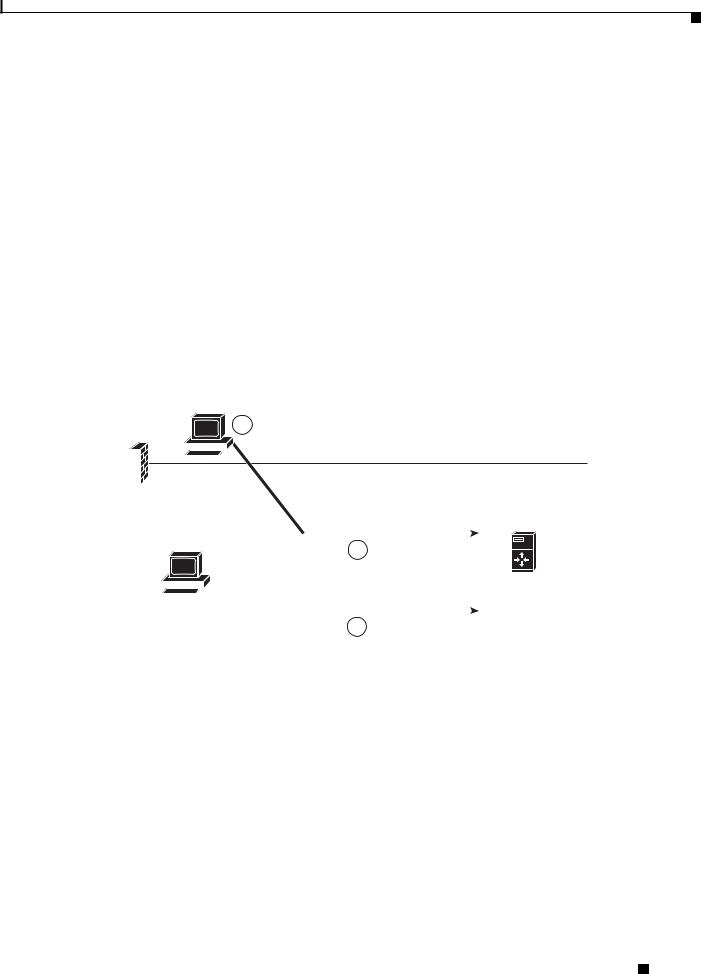
Chapter 1 Introducing Cisco Unified MeetingPlace Web Conferencing
About Cisco Unified MeetingPlace Web Conferencing
How Users Connect to Web Conferencing
Users connect to the Web Conferencing home page to sign in, schedule or find meetings to attend, and update their profile settings. This connection uses the primary IP address (or hostname) configured on the Web Conferencing server and port 80.
When a meeting is scheduled to begin, the Cisco MeetingPlace Agent Service instructs the web engine to initiate the meeting. As users join the web component of the meeting, the Flash-based meeting console is downloaded on their desktops, allowing them to connect to the Flash Media Server running on the Web Conferencing system by using the secondary IP address (or hostname) configured on the server.
The meeting console communicates with the Flash Media Server on the Web Conferencing server through TCP port 1627, as shown in Figure 1-1. If this port is blocked due to a firewall, the Flash client establishes a tunnel connection over HTTP through port 80. This process allows the meeting console to bypass firewall restrictions so that external users can participate in web conferences.
The web server also supports tunneling over HTTPS by using Secure Sockets Layer (SSL).
Figure 1-1 How Users Communicate with Cisco Unified MeetingPlace Web Conferencing
Using the home page and meeting console
1
|
|
|
|
|
|
|
|
|
|
|
|
|
|
|
|
|
|
|
|
|
|
|
|
|
|
|
|
|
|
|
|
|
|
|
|
|
|
|
|
Using the |
(TCP port 80) |
|
|
||||||||
|
|
|
||||||||||
|
|
|
|
|
||||||||
|
home page |
|
2 |
|
|
|
||||||
|
|
|
|
|
|
|
|
|
|
|
|
|
|
|
|
|
|
|
|
|
|
(TCP port 1627) |
Web- |
|
|
|
|
|
|
|
|
|
|
|
|
|||
|
|
|
|
|
|
|
|
|
|
|||
|
Using the |
|
|
|
conferencing |
|
||||||
|
|
|
|
|
|
|
||||||
|
|
|
|
|
|
server |
|
|||||
|
|
|
|
3 |
|
|
||||||
|
meeting console |
|
|
|
||||||||
|
|
|||||||||||
|
|
|
|
|
|
|
|
|
|
|
|
|
191838
1.For external participants, the meeting console tunnels communication by using HTTP through TCP port 80.
2.Cisco Unified MeetingPlace Web Conferencing home page traffic (signing on, scheduling meetings, changing profile settings, etc.) for both internal and external participants uses port 80.
3.For internal participants using the meeting console, connection is made directly to the web server over TCP port 1627.
How Web Conferencing Fulfills Requests
Figure 1-2 shows how Cisco Unified MeetingPlace Web Conferencing components work together to fulfill user requests.
Installation and Upgrade Guide for Cisco Unified MeetingPlace Web Conferencing Release 6.x
|
OL-13418-01 |
1-5 |
|
|
|
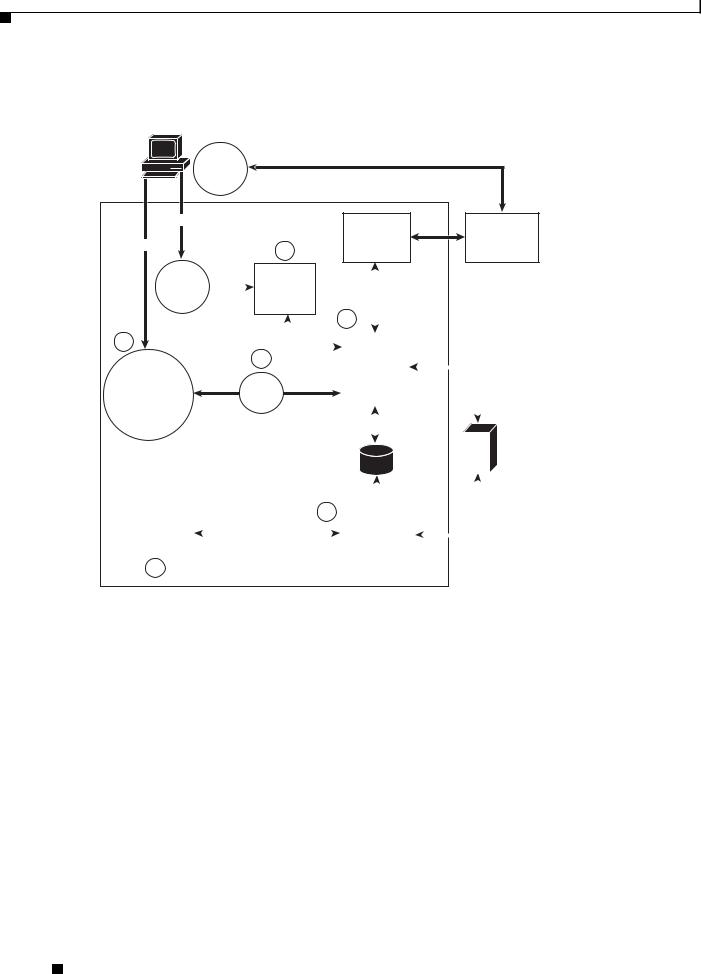
Chapter 1 Introducing Cisco Unified MeetingPlace Web Conferencing
About Cisco Unified MeetingPlace Web Conferencing
Figure 1-2 Cisco Unified MeetingPlace Web Conferencing Components
|
Internet browser |
|
|
|
|
Video |
|
|
|
|
endpoint |
|
|
|
|
Flash |
Video |
Multipoint |
|
|
|
|||
HTTP |
3 |
Service |
Control |
|
(optional) |
Unit |
|||
|
|
meeting |
|
Flash |
|
|
|
|
|
|
|
|
|
|
|
|||
|
|
Media |
|
|
|
|
|
|
|
|
|
|
|
||||
|
console |
|
|
|
|
|
|
|
|
|
|
|
|
||||
|
|
Server |
|
|
|
|
|
|
|
|
|
|
|
||||
|
|
|
|
|
|
|
|
|
|
|
|
|
|
|
|
||
1 |
|
|
2 |
|
4 |
|
|
|
|
|
|
|
|
||||
|
|
|
|
|
|
|
|
||||||||||
|
|
|
|
|
|
|
|
|
|
|
|
|
|
||||
|
|
|
|
|
Agent |
|
|
|
|
|
Gateway SIM |
||||||
|
|
|
|
|
|
|
|
|
|
||||||||
|
Web |
|
|
|
|
|
Service |
|
|
|
|
|
|||||
|
|
|
|
|
|
|
|
|
|
|
|||||||
|
|
|
|
|
|
|
|
|
|
|
|
|
|
|
|||
Conferencing |
|
ISAPI |
|
|
|
|
|
|
|
|
|
|
|
||||
Home Page |
|
|
|
|
|
|
|
|
|
|
|
|
|
Cisco Unified |
|||
|
|
|
|
|
|
|
|
|
|
|
|
|
|||||
|
|
|
|
|
|
|
|
|
|
|
|
|
|
|
|
|
|
|
|
|
|
|
|
|
|
|
|
|
|
|
|
|
|
|
|
|
|
|
|
|
|
|
|
|
|
|
|
|
|
|
|
|
MeetingPlace |
|
|
|
|
|
|
|
|
|
|
|
|
|
|
|
|
||
|
|
|
|
|
|
|
|
|
|
SQL |
|
|
Audio Server |
||||
|
|
|
|
|
|
|
|
|
|
Server |
|
|
System |
||||
|
|
|
|
|
|
|
5 |
|
|
|
|
|
|
|
|
|
|
|
|
|
|
|
|
|
|
|
|
|
|
|
|
|
|
|
|
|
Audio |
|
|
|
|
|
|
Replication |
|
|
|
|
Gateway SIM |
||||
|
|
|
|
|
|
|
|
|
|
|
|||||||
|
Service |
|
|
|
|
|
|
Service |
|
|
|
|
|
||||
|
|
|
|
|
|
|
|
|
|
|
|
|
|
|
|
|
|
6
191839
1.Users submit requests to schedule meetings, change their profile, and join meetings.
2.ISAPI processes user requests for the Cisco MeetingPlace Agent Service and generates HTML pages to display to users for meeting scheduling, meeting details, and account update pages.
3.When users join a meeting, their meeting consoles connect to the Flash Media Server on the Cisco Unified MeetingPlace Web Conferencing server.
4.The Agent Service manages all user requests from ISAPI and accomplishes the following:
–Passes the scheduling requests and profile updates to the Cisco Unified MeetingPlace Audio Server system.
–Coordinates between the meeting room components (Connect Gateway, Connect Application Service, Flash Media Administration Server, and Flash Media Server) and the rest of the Cisco Unified MeetingPlace system.
–Acts as a communication channel between the Audio Server system and the Video Service. For information about the Video Service, refer to the Administration Guide for Cisco Unified MeetingPlace Video Integration.)
–Retrieves and stores information in the MPWEB database.
Installation and Upgrade Guide for Cisco Unified MeetingPlace Web Conferencing Release 6.x
1-6 |
OL-13418-01 |
|
|

Chapter 1 Introducing Cisco Unified MeetingPlace Web Conferencing
Terms of Use
(For more information about the Agent Service, see the “Overview of the Cisco MeetingPlace Agent Service” section on page 1-4.)
5.The Replication Service copies meeting materials from the Audio Server system and stores them on the web server. Pointers to the data are kept in an SQL Server database. The Replication Service also forwards voice recordings to the Audio Service for file conversion.
6.The Audio Service converts voice recordings and passes the converted files back to the Replication Service.
Terms of Use
This section contains information on particular terms of agreement that you should be aware of when configuring or using this product:
•Configuration Restrictions, page 1-7
•Cisco Policy for Use of Third-Party Software, page 1-7
•Terms for Single Sign On Software Integration, page 1-7
•Terms of Support for Single Sign On Software Integration, page 1-8
Configuration Restrictions
Cisco Unified MeetingPlace Web Conferencing deployments that are customized beyond the built-in configuration capabilities of the product, or beyond the documented configuration settings, procedures or instructions, are not supported by Cisco Systems.
Examples of such customizations include, but are not limited to, the following: modifying web page templates, changing HTML or Javscript code, changing IIS running parameters or applying custom ASP pages or ISAPI filters, modifying SQL server configuration or authentication method, and modifying Windows OS security through IPSec policies and NTFS ACL.
Cisco Policy for Use of Third-Party Software
The Cisco Unified MeetingPlace Web Conferencing documentation describes the system, end user, and other requirements for the use of Web Conferencing software. Failure to meet these requirements or the introduction of certain third-party products may interfere with the operation of the Cisco Unified MeetingPlace Web Conferencing software, and may affect Cisco support for the Web Conferencing product.
Terms for Single Sign On Software Integration
•Customer Premise Equipment (CPE) customers who implement SSO software integrations on their Cisco Unified MeetingPlace web servers do so at their own risk and are responsible for understanding the technical implementations and feasibility of SSO integrations on their systems.
•By allowing SSO software integrations, we do not claim support for any SSO software packages or vendors.
Installation and Upgrade Guide for Cisco Unified MeetingPlace Web Conferencing Release 6.x
|
OL-13418-01 |
1-7 |
|
|
|

Chapter 1 Introducing Cisco Unified MeetingPlace Web Conferencing
Terms of Use
•SSO software integrations require proper configuration of Cisco Unified MeetingPlace Web Conferencing systems through the Admin pages. If your SSO software integration requires a change in the Cisco Unified MeetingPlace Web Conferencing product source code, your SSO integration becomes an SSO customization, and we do not support customizations by either customers or any other parties.
•CPE customers who want to integrate SSO packages can contact Cisco Managed Services to obtain a Service Request to implement SSO. This service is offered as a convenience and does not change the scope of the SSO integration: this service is an integration and configuration of the Cisco Unified MeetingPlace Web Conferencing product, not a customization of the product code.
•Customers must first implement SSO software integrations on test or lab servers and verify that the integrated systems work, including Cisco Unified MeetingPlace Web Conferencing features and operations.
•Customers are responsible for ensuring stability of integrated Cisco Unified MeetingPlace Web Conferencing-SSO systems, including communicating with SSO software vendors for the following reasons:
–To obtain necessary fixes and support
–To troubleshoot functional problems and technical problems, including crashes triggered by the SSO package
•SSO software often includes a web-server extension, called the IIS ISAPI extension or filter. Cisco Unified MeetingPlace Web Conferencing installs and uses four IIS extensions. Any incompatibility between an SSO software extension and the Cisco Unified MeetingPlace Web Conferencing extensions can make IIS non-functional or unstable. Any crash of the SSO IIS extension can cause IIS to crash and can generate a full Cisco Unified MeetingPlace Web Conferencing outage, resulting in a full system reboot, ending of in-progress meetings, and disconnecting of web-conferencing users. Any memory leak in the SSO package or module can make IIS or the whole server unstable, as well.
•Although SSO software integration is productized for the Cisco Unified MeetingPlace Web Conferencing system, any changes in overall configuration, including Cisco Unified MeetingPlace Web Conferencing upgrades and SSO package upgrades, can potentially break integrated Cisco Unified MeetingPlace Web Conferencing-SSO systems.
Terms of Support for Single Sign On Software Integration
•Customers must inform Cisco TAC that their Cisco Unified MeetingPlace Web Conferencing servers have third-party SSO packages installed and configured with Cisco Unified MeetingPlace Web Conferencing when opening a service request for Cisco Unified MeetingPlace Web Conferencing, Cisco Unified MeetingPlace for Microsoft Outlook, or Cisco Unified MeetingPlace for Lotus Notes.
•Customers must be able to provide SSO integration details upon request. Inability to provide details can result in Cisco TAC not being able to proceed with service requests.
•If a service request is about troubleshooting the SSO integration, Cisco TAC can review the logs and identify if the problem is on the SSO side or the Cisco Unified MeetingPlace Web Conferencing side. If the problem is on the SSO side, information will be provided to customers, so they can further troubleshoot with their SSO vendors.
•If the service request is about troubleshooting a Cisco Unified MeetingPlace Web Conferencing problem that does not seem to be connected to the SSO integration, Cisco TAC will proceed per the normal support process. If TAC discovers that the SSO integration plays a role in the problem, information will be provided to customers, so they can further troubleshoot with their SSO vendors.
Installation and Upgrade Guide for Cisco Unified MeetingPlace Web Conferencing Release 6.x
1-8 |
OL-13418-01 |
|
|
